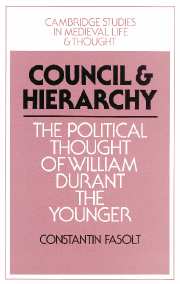Book contents
- Frontmatter
- Contents
- Acknowledgments
- List of abbreviations
- List of manuscript sigla
- INTRODUCTION
- PART I THE FORMATION OF INTEREST
- 1 THE BISHOPS OF MENDE
- 2 THE STATE OF THE CHURCH
- 3 THE TWILIGHT OF AUTONOMY
- RESULTS: LIBERTY AND COMPROMISE
- PART II THE ASSERTION OF JUSTICE
- PART III THE INCIDENCE OF POWER
- CONCLUSION
- Appendix: A note on texts and citations
- Bibliography
- Concordance
- Index
- Cambridge studies in medieval life and thought Fourth series
RESULTS: LIBERTY AND COMPROMISE
Published online by Cambridge University Press: 06 July 2010
- Frontmatter
- Contents
- Acknowledgments
- List of abbreviations
- List of manuscript sigla
- INTRODUCTION
- PART I THE FORMATION OF INTEREST
- 1 THE BISHOPS OF MENDE
- 2 THE STATE OF THE CHURCH
- 3 THE TWILIGHT OF AUTONOMY
- RESULTS: LIBERTY AND COMPROMISE
- PART II THE ASSERTION OF JUSTICE
- PART III THE INCIDENCE OF POWER
- CONCLUSION
- Appendix: A note on texts and citations
- Bibliography
- Concordance
- Index
- Cambridge studies in medieval life and thought Fourth series
Summary
The purpose of the preceding chapters has been to define the context in which William Durant the Younger composed the Tractatus Maior. Generally speaking, that context consisted of the relation between local government and central government; but it brought together actors of different social origins with varying ideas of social order who added a considerable measure of complexity to the underlying pattern. Over a period of about 200 years the situation in the Gévaudan thus underwent a series of permutations, none of which abolished entirely what had come before but each of which added another layer of motives and memories. Indeed, the changes were so profound that one may wonder if the relationship between Aldebert de Tournel and Louis VII was at all comparable with that between William Durant and Philip IV. It may therefore be useful to summarize these developments and state a few conclusions.
The story we have told involved three main participants – the bishop, the local nobility, and the rulers of church and state – and it unfolded in three phases. During the first phase, the bishop took the lead by introducing reform to the Gévaudan in an attempt to shake off his dependence on the laity and to establish himself as sole lord of ‘the entire bishopric of Gévaudan’.
- Type
- Chapter
- Information
- Council and HierarchyThe Political Thought of William Durant the Younger, pp. 101 - 112Publisher: Cambridge University PressPrint publication year: 1991

